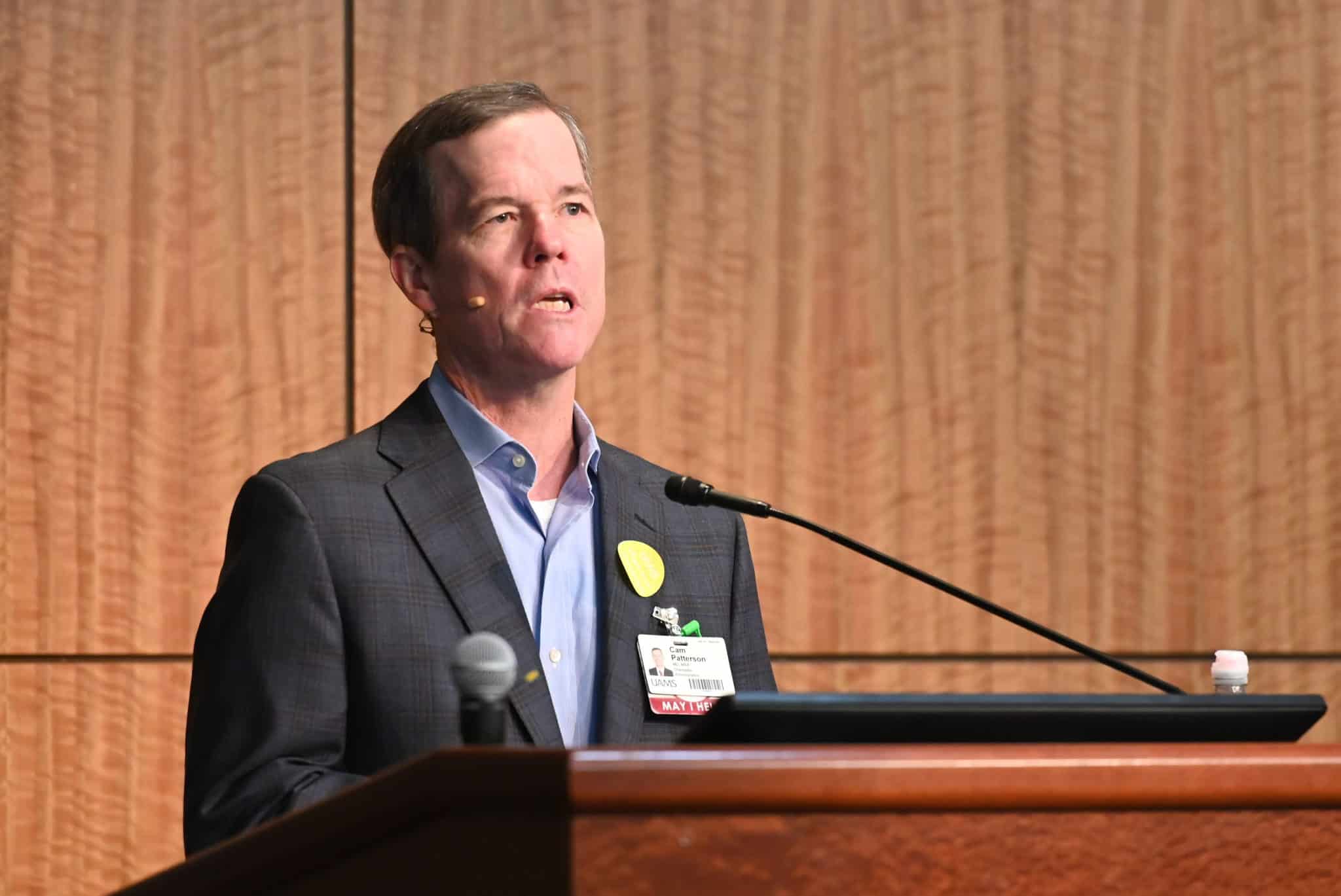UAMS Leaders Present Sunny Picture at September Town Hall
| Chancellor Cam Patterson, M.D., MBA, kicked off his monthly Town Hall meeting Sept. 30 by showing the “Heroes Work Here” video.
Produced by the Office of Communications & Marketing for the UA Board of Trustees meeting earlier in the month, the video shares the experiences of employees on the front-line of the battle against COVID-19.
“I’m proud to be a part of this incredible team,” Patterson said at the video’s conclusion. “You are all heroes.”
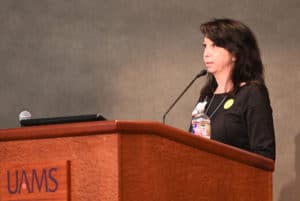
Chief Operating Officer Christina Clark gives an update on campus energy projects, including the construction of the east generator plant.
The Town Hall meeting covered a lot of ground, including reports on the new generator plant and other energy projects, Vision 2029, UAMS’ finances, Human Resources updates and the College of Public Health’s latest COVID-19 projections.
Christina Clark, MBA, vice chancellor for institutional support services and chief operating officer, gave an update on the east generator plant, which is under construction on the east side of campus between Pine and Cedar streets. Site excavation has been completed, Clark said, with workers removing more than 2,850 cubic yards of rock from the site. Once the plant is complete, it will provide 24 megawatts of power and allow the campus to operate independently from the utility grid when necessary, she said.
Also underway are projects working on the electrical distribution system, central heating and cooling plant. Clark said the project team has installed more than eight miles of electrical conduit throughout the campus for the new essential power distribution system, which will connect the new generators to the essential power circuits across the campus. This distribution will allow the removal of 20 existing smaller generators.
The Barton Research Building is also part of the ongoing energy projects. Of the changes there, the most visible will be new exterior window walls, Clark said, but the building also will receive new HVAC, electrical, elevators, fire alarm and sprinkler systems. This work should be finished by mid-June 2021.
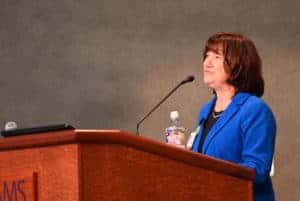 The final piece of the energy project puzzle is the revamping of Pine and Cedar streets. The team has submitted the final plans to the City of Little Rock for approval, Clark said, adding the team hopes to begin construction in mid-October with the work completed by summer of 2022. The new outdoor fitness court is already under construction and should be completed and available for use in early 2021, she said.
The final piece of the energy project puzzle is the revamping of Pine and Cedar streets. The team has submitted the final plans to the City of Little Rock for approval, Clark said, adding the team hopes to begin construction in mid-October with the work completed by summer of 2022. The new outdoor fitness court is already under construction and should be completed and available for use in early 2021, she said.
Stephanie Gardner, Pharm.D., Ed.D., senior vice chancellor for academic affairs, provost and chief strategy officer, reported progress on meeting the objectives of the Vision 2029 strategic plan, the 10-year plan for transforming Arkansas into the healthiest state in the region through its clinical care, research and academic missions.
UAMS created 38 objectives across the institution as part of the strategic plan with 850 annual targets.
“Despite the pandemic and the financial challenges caused by the pandemic — the loss of revenue, the necessary hiring pause and spending restrictions and more, we have made tremendous progress on our goals,” Gardner said. She cited the creation of the UAMS Health system, the implementation of a living wage for all employees and the progress made toward obtaining NCI designation for the Winthrop P. Rockefeller Cancer Institute.
Of the 850 annual targets for the fiscal year ending June 2021, 97 of them were achieved in the first quarter of the fiscal year. These include a significant expansion of telemedicine visits, she said.
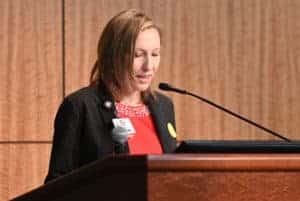
Chief Financial Officer Amanda George reports a better than expected financial picture for UAMS.
Digital health is an area where the accomplishments are especially impressive — and actually driven in part by COVID and the need to quickly expand telemedicine services to our patients, she said. “We had a 2021 goal of using telemedicine visits on 30% of our Regional Campuses, and we are now providing telemedicine visits on all eight regional campuses,” she said.
“UAMS also set a 2029 goal to increase by 90 percent — compared to 2018 — the number of patients seen via telemedicine,” Gardner said. “From January 2019 to the end of February 2020, we completed 1,256 digital health visits across our phone, video and other digital platforms. From March 1 of this year through August 10, we completed 45,802 visits. That is an increase of more than 3,000 percent — 36 times more than in 2019.”
Continuing the good news, Amanda George, MHSA, CPA, vice chancellor for finance and chief financial officer, reported that UAMS’s financial situation was much better than expected. UAMS ended the 2020 fiscal year with a $15.7 million loss, much less than expected, she said. Also, the 2021 fiscal year budget expected clinical revenues to continue to be depressed in the first quarter, which hasn’t happened.
“While our key clinical volume indicators are down slightly from this point last year, most of them are higher than we expected when we put our 2021 budget together,” she said.
UAMS is running a nearly $15 million surplus through August, she said, noting that leaders had budgeted a $30 million deficit. A combination of higher than expected volumes and receipt of an additional $16 million from the CARES Act are the primary reasons we are performing so well against budget.
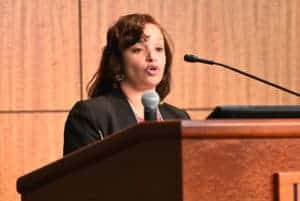
Chief Human Resources Officer Danielle Lombard-Sims, Ph.D., urges everyone to take time to vote.
This improved financial condition allowed UAMS to lift the hiring pause and the freeze on discretionary spending, she said.
Danielle Lombard Sims, Ph.D., vice chancellor for human resources and chief human resources officer, encouraged everyone to vote, noting that voter registration ends in Arkansas on Oct. 5. Early voting is Oct. 19 through Nov. 2, she said, and the general election is Nov. 3.
Employees are allowed to arrive late or leave early in order to vote, she said, adding that time is provided with pay. More information about the election is on the HR website.
“We care about our employees, and we know employee engagement has far reaching effects in organizational culture, employee turnover and even patient experience here on campus,” she said. “So far, 91% of our departments have submitted their action plans, and the vast majority of employees have worked with their leaders to help UAMS continue to be an outstanding place to work.”
This is also time for performance reviews, she said, noting the period to complete reviews for all non-faculty staff is Sept. 1 through Oct. 31.
Open enrollment is scheduled for November 1 – 30. Employees will be able to make changes to their benefits during November, she said, adding the UA System is holding a Virtual Benefits Fair from Oct. 1 through Nov. 30.
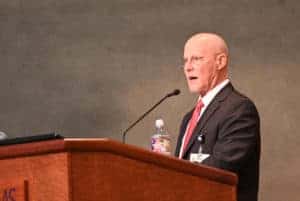
Mark Williams, Ph.D., dean of the College of Public Health, presents the college’s latest forecasts for the COVID-19 pandemic in Arkansas.
Mark Williams, Ph.D., dean of the College of Public Health, presented the college’s 15-day, six-week and long-term COVID-19 forecasts and projections for the state.
The 15-day forecast of cumulative COVID-19 cases by Oct. 5 will be 86,118, an increase of 5,363 cases over the actual number of cases reported Sept. 27, he said. The 15-day model for hospitalizations indicates Arkansas will have 6,144 cumulative hospitalizations on Oct. 5 and 2,069 cumulative intensive care patients.
“To put it another way, one-third of patients admitted to a hospital for COVID-19 in Arkansas will require intensive care,” Williams said.
The15-day model also forecasts 1,375 cumulative deaths, he said.
“By Nov. 15, we are predicting Arkansas will have 124,054 cumulative cases, an increase of almost 44,000 cases over the number of actual cases on Sept. 27, Williams said. “Using the same procedures, we are projecting the number of COVID-19 deaths on Nov. 15 will be 2,501.”
Finally, the long-term model projects the pandemic will peak in Arkansas on Feb. 22 with 58,000 active cases, 1,401 people hospitalized — of whom 490 will require intensive care and 171 will be on ventilators, he said. The model is also projecting 68 people will die that day from COVID-19.
Williams noted the long-term forecast has changed from previous models, likely a result of a decrease in the daily infection rate among Arkansans. This model sees a later and smaller peak than previous forecasts.
More information about the college’s models are available at publichealth.uams.edu/.
